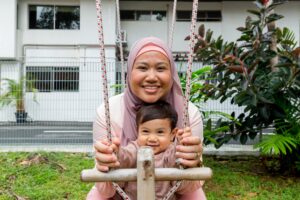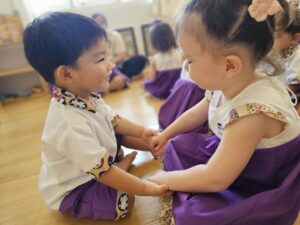Our children are always on the move, as they should be! In parts one and two of this series, we talked about the importance of movement in your child’s cognitive development. We covered fine motor skills from birth on up, but what about that other category of movement? Gross motor skills are all about big body movements using arms, legs and the torso. These skills are very important–inside and outside of the classroom! Gross motor skills let our children do everyday activities like walk and get dressed; they are the basis for sporting activities like running, jumping, and climbing; and in school children need the correct posture for sitting at tables, coordination to carry the red rods to their floor mat, and independence to use the toilets. At House on the Hill gross motor activity is happening inside and outside the classroom, and with every jump, dance, or balanced tray holding we are learning and having fun.
Montessori Movement
Unlike many traditional classrooms, Montessori children are on the move and moving their bodies in big ways all morning long. Children are not confined to their desks, instead they can choose to work at tables or on mats on the floor. Different materials around the room even encourage gross motor movement. The Pink Tower and Brown Stairs are often combined to create carefully balanced, tall structures that require stretching. When children work with the red rods or the number rods they learn to carry the materials to their floor mats carefully, even when the rod may be taller than them! In many Montessori classrooms you’ll find a line on the floor that children walk on to learn balance, a practice created by Dr. Montessori.
Gross motor activity in the classroom has many benefits, too. Beyond the physical benefits of strong muscles and preventing weight gain, there are cognitive benefits. Allowing children to move about during the day increases their attention and memory; exercise actually helps nerve cells multiply, creating more connections.
Bouncing Beyond the Classroom
Given the health and academic gains that come from gross motor activity, we do not limit it to in-class activities. Our students get their wiggles out and their fun in on our beautiful wooden playground structures where they can slide, climb and swing. At each school we maximize our outdoor space and encourage children to play and explore in the garden and practice their balance as they coast on striders. We balance this free play with more structured gross motor activities, as well. We may create different obstacle courses that teach specific skills such as hopping on one foot, balancing on a plank, or crawling through a tunnel.
Of course the element that inspires the most movement is always music. We have Music and Movement time in our playgroup where our youngest learn different dance moves and how to move to a beat. For various events throughout the year, be it Lunar New Year or National Day, you can find all of our children and teachers dancing as one!
Gross Motor At Home
Getting enough daily gross motor activity time is harder today than ever before. We must be thoughtful and deliberate about making sure our children are moving their bodies all day long, even when they get home from school! By making gross motor movement a healthy habit in your home you will be setting your child up for a future of physical health and success in school. But where to begin?
We recommend heading outdoors. Check your neighborhood for a park, and if possible walk or ride your scooter there. Meeting friends at the playground is a great way to stay accountable for getting outdoors and your child will love the play time.
As with all Montessori we recommend a mix of structured and free time. You can consider bringing very simple materials with you–a ball, a frisbee, or even a kite and after introducing how to use the material letting your child try on their own for a while (of course you can also join them for a game of catch!). If you are teaching your child a new skill you can use the Montessori model: instead of using many words to explain the action, instead just demonstrate to your child in slow motion a few times and then let them try. If it seems too advanced and they are growing frustrated, try a variation of the movement that they can achieve and build up from there. And most importantly, have fun!
This post is part of our ongoing series on motor skills. Check out Part 1 and Part 2 here!








